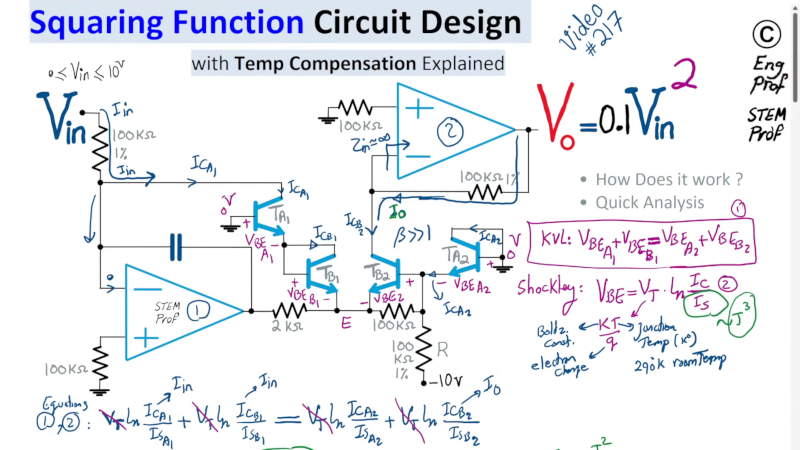Innovative Circuit Design: Squaring Voltage with Precision

In the world of electronics, a new challenge emerges: squaring an input voltage with precision. The task, while seemingly straightforward, involves complex calculations and innovative circuit design. For instance, squaring an input of 8 volts would typically yield 64 volts, but the goal here is to achieve an output that is 10% of that square, resulting in 6.4 volts. This intricate process is demystified by an engineering professor who demonstrates the solution in a detailed video tutorial.
The circuit design utilizes two operational amplifiers (op amps) and a series of transistors. However, the implementation of these transistors is influenced by temperature variations, necessitating the use of a transistor array to ensure they are matched and maintain a consistent temperature. This precision is crucial for the circuit’s accuracy and efficiency.
The Science Behind the Circuit
The underlying mathematics of this circuit design is rooted in the natural logarithmic properties of transistor responses. The principle that the sum of two logarithms equals the logarithm of the product of two numbers plays a pivotal role in simplifying the calculations. Due to the matching of transistors, many terms in the equations cancel out, streamlining the process.
Transistors, being current devices, produce an output current that is the input current squared, divided by the output transistor’s collector current. The challenge lies in converting the voltage to a current and back again, using precise scaling techniques.
Expert Insights and Practical Applications
According to the engineering professor, this innovative approach is not just an academic exercise but has practical applications, particularly in analog computing. “Squaring a voltage is essential for various computational processes in analog computers,” the professor explains in the video.
“The math depends on the fact that the transistor response has a natural log term in it, and the property that the sum of two logs is the same as the log of the product of the numbers.”
Such insights highlight the elegance and complexity of the design, offering a glimpse into the intricate world of circuit engineering.
Historical Context and Future Implications
The concept of squaring voltage is not new, but the methods and technologies used to achieve it have evolved significantly. In the early days of electronics, achieving such precision required bulky and inefficient equipment. Today, advancements in semiconductor technology and circuit design have made it possible to achieve the same results with far greater efficiency and accuracy.
Looking forward, the implications of this design are vast. As technology continues to advance, the need for precise and efficient voltage manipulation will only grow. This development represents a step forward in the quest for more powerful and efficient electronic devices.
Conclusion and Next Steps
The innovative circuit design for squaring voltage, as demonstrated by the engineering professor, showcases the blend of theoretical mathematics and practical engineering. By leveraging the properties of transistors and operational amplifiers, this approach not only solves a complex problem but also opens the door to new possibilities in electronics and computing.
For those interested in delving deeper into the mathematics and technical details, the professor’s video provides a comprehensive guide. As technology continues to evolve, such innovations will undoubtedly play a crucial role in shaping the future of electronics.





